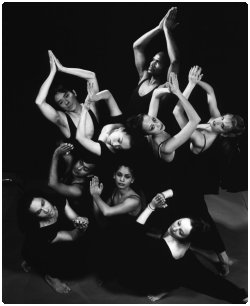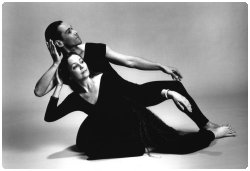
World Premier – Vernal Equinox, March 20, 1997 at St. Mark’s Danspace, NYC
Concept & Choreography: Janaki Patrik, Artistic Director, The Kathak Ensemble & Friends, NYC
In collaboration with Ramli Ibrahim, Artistic Director, Sutra Dance Theater, Malaysia
Music Composed and Conducted by Michael Ward
Orchestrations by Bruno Casolari & Michael Ward
Consultant on Vedic chant and Sanskrit translation – Dr. P. Jayaraman
Dancers:
Ramli Ibrahim – Purush
Janaki Patrik – Prakriti
Retaamsi: David Browne, Benedette Capanno, Richard Chang, Aimee Phelan, Masud-ur-Rahman, Aparna Reddy, Masayo Tomita
Soloists:
Peter Fagiola – Pakhawaj, frame drums & western percussion
Michell Greenberg – Bansuri & shehnai
Dr. P. Jayaraman – Vedic Chant
Usha Kallianpurkar – Hindustani classsical vocal
Pandit Ramesh Misra – North Indian sarangi
Willie Moller – Soprano (Grace Church Boy Choir)
Nell Snaidas – Soprano
Chorus:
Lorelei & Hardy, Gayle Swymer, Choral Director
Orchestra:
Kurt Coble, Concertmaster

MANDALA X / CREATION : A Dance Oratorio is inspired by “The Hymn of Creation”, a 3,000-year-old Sanskrit hymn from the Rig Veda. Man’s first recorded speculation on the origins of the universe — considered the oldest statement of philosophic doubt in world literature — the Hymn of Creation reverberates with eternal questions which have intrigued man and are still posed by modern astrophysicists.

MANDALA X’s choreographic structure evolves from the mandala. A ritual design symbolic of the universe, a mandala is also any of the ten books of hymns that comprise the Rig Veda, Hinduism’s most ancient sacred text. The Hymn of Creation is included in the tenth and last book of the Rig Veda, Mandala X. The title of this work, therefore, refers both to a specific text and to geometric form. The choreography draws freely from modern dance and theater techniques, as well as from Eastern dance idioms, and it suggests the powerful forces out of which the universe is imagined to have emerged: purush – male, matter; prakriti – female, energizing nature; retaamsi – seeds; salila – water; tamas – darkness; tapas – inner, refining fire; kamas – desire; manas – thought.